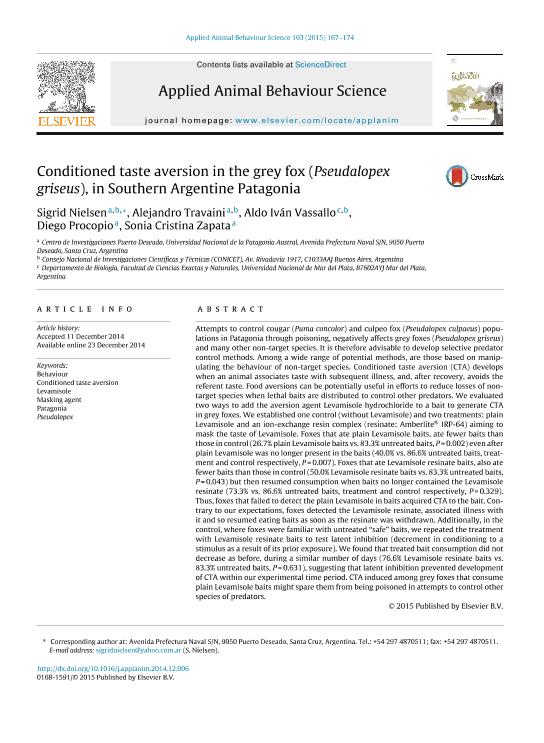Artículo
Conditioned taste aversion in the grey fox (Pseudalopex griseus), in Southern Argentine Patagonia
Nielsen, Sigrid ; Travaini, Alejandro
; Travaini, Alejandro ; Vassallo, Aldo Iván
; Vassallo, Aldo Iván ; Procopio, Diego Esteban
; Procopio, Diego Esteban ; Zapata, Sonia Cristina
; Zapata, Sonia Cristina
 ; Travaini, Alejandro
; Travaini, Alejandro ; Vassallo, Aldo Iván
; Vassallo, Aldo Iván ; Procopio, Diego Esteban
; Procopio, Diego Esteban ; Zapata, Sonia Cristina
; Zapata, Sonia Cristina
Fecha de publicación:
02/2015
Editorial:
Elsevier Science
Revista:
Applied Animal Behaviour Science
ISSN:
0168-1591
Idioma:
Inglés
Tipo de recurso:
Artículo publicado
Clasificación temática:
Resumen
Attempts to control cougar (Puma concolor) and culpeo fox (Pseudalopex culpaeus) populations in Patagonia through poisoning, negatively affects grey foxes (Pseudalopex griseus) and many other non-target species. It is therefore advisable to develop selective predator control methods. Among a wide range of potential methods, are those based on manipulating the behaviour of non-target species. Conditioned taste aversion (CTA) develops when an animal associates taste with subsequent illness, and, after recovery, avoids the referent taste. Food aversions can be potentially useful in efforts to reduce losses of non-target species when lethal baits are distributed to control other predators. We evaluated two ways to add the aversion agent Levamisole hydrochloride to a bait to generate CTA in grey foxes. We established one control (without Levamisole) and two treatments: plain Levamisole and an ion-exchange resin complex (resinate: Amberlite® IRP-64) aiming to mask the taste of Levamisole. Foxes that ate plain Levamisole baits, ate fewer baits than those in control (26.7% plain Levamisole baits vs. 83.3% untreated baits, P=0.002) even after plain Levamisole was no longer present in the baits (40.0% vs. 86.6% untreated baits, treatment and control respectively, P=0.007). Foxes that ate Levamisole resinate baits, also ate fewer baits than those in control (50.0% Levamisole resinate baits vs. 83.3% untreated baits, P=0.043) but then resumed consumption when baits no longer contained the Levamisole resinate (73.3% vs. 86.6% untreated baits, treatment and control respectively, P=0.329). Thus, foxes that failed to detect the plain Levamisole in baits acquired CTA to the bait. Contrary to our expectations, foxes detected the Levamisole resinate, associated illness with it and so resumed eating baits as soon as the resinate was withdrawn. Additionally, in the control, where foxes were familiar with untreated "safe" baits, we repeated the treatment with Levamisole resinate baits to test latent inhibition (decrement in conditioning to a stimulus as a result of its prior exposure). We found that treated bait consumption did not decrease as before, during a similar number of days (76.6% Levamisole resinate baits vs. 83.3% untreated baits, P=0.631), suggesting that latent inhibition prevented development of CTA within our experimental time period. CTA induced among grey foxes that consume plain Levamisole baits might spare them from being poisoned in attempts to control other species of predators.
Archivos asociados
Licencia
Identificadores
Colecciones
Articulos(IIMYC)
Articulos de INSTITUTO DE INVESTIGACIONES MARINAS Y COSTERAS
Articulos de INSTITUTO DE INVESTIGACIONES MARINAS Y COSTERAS
Articulos(SEDE CENTRAL)
Articulos de SEDE CENTRAL
Articulos de SEDE CENTRAL
Citación
Nielsen, Sigrid; Travaini, Alejandro; Vassallo, Aldo Iván; Procopio, Diego Esteban; Zapata, Sonia Cristina; Conditioned taste aversion in the grey fox (Pseudalopex griseus), in Southern Argentine Patagonia; Elsevier Science; Applied Animal Behaviour Science; 163; 2-2015; 167-174
Compartir
Altmétricas



